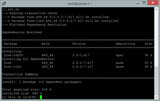Instalējiet Plesk operētājsistēmā CentOS 7
Vai izmantojat citu sistēmu? Plesk ir patentēts tīmekļa mitinātāja vadības panelis, kas ļauj lietotājiem administrēt savas personīgās un/vai klientu vietnes, datu bāzes
Lychee 3.1 Photo Album is a simple and flexible, free and open source photo-management tool which runs on a VPS server. It installs in a matter of seconds, enabling you to upload, manage, and share photos quickly and securely. Lychee 3.1 features Dropbox import, (with a valid drop-ins app key). It can be expanded with new features via plug-ins which can, for instance, allow you to sync with any directory containing photos, upload photos via SSH, create RSS feeds out of your photos, add watermarks to your photos, plus many other advanced and useful features.
In this tutorial, we are going to install Lychee 3.1 Photo Album on a CentOS 7 LAMP VPS using Apache web server, PHP 7.1, and a MariaDB database.
We will start by adding a new sudo user.
First, log into your server as root:
ssh root@YOUR_VULTR_IP_ADDRESS
Add a new user called user1 (or your preferred username):
useradd user1
Next, set the password for the user1 user:
passwd user1
When prompted, enter a secure and memorable password.
Now check the /etc/sudoers file to make sure that the sudoers group is enabled:
visudo
Look for a section like this:
%wheel ALL=(ALL) ALL
This line tells us that users who are members of the wheel group can use the sudo command to gain root privileges. It will be uncommented by default, so you can simply exit the file.
Next we need to add user1 to the wheel group:
usermod -aG wheel user1
We can verify the user1 group membership and check that the usermod command worked with the groups command:
groups user1
Now use the su command to switch to the new sudo user user1 account:
su - user1
The command prompt will update to indicate that you are now logged into the user1 account. You can verify this with the whoami command:
whoami
Now restart the sshd service so that you can login via ssh with the new non-root sudo user account you have just created:
sudo systemctl restart sshd
Exit the user1 account:
exit
Exit the root account (which will disconnect your ssh session):
exit
You can now ssh into the server instance from your local host using the new non-root sudo user user1 account:
ssh user1@YOUR_VULTR_IP_ADDRESS
If you want to execute sudo without having to type a password every time, then open the /etc/sudoers file again, using visudo:
sudo visudo
Edit the section for the wheel group so that it looks like this:
%wheel ALL=(ALL) NOPASSWD: ALL
Please note: Disabling the password requirement for the sudo user is not a recommended practice, but it is included here as it can make server configuration much more convenient and less frustrating, especially during longer systems administration sessions. If you are concerned about the security implications, you can always revert the configuration change to the original after you finish your administration tasks.
Whenever you want to log into the root user account from within the sudo user account, you can use one of the following commands:
sudo -i
sudo su -
You can exit the root account and return back to your sudo user account any time by simply typing the following:
exit
Before installing any packages on the CentOS server instance, we will first update the system.
Make sure you are logged into the server using a non-root sudo user and run the following command:
sudo yum -y update
Install the Apache web server:
sudo yum -y install httpd
Then use the systemctl command to start and enable Apache to execute automatically at boot time:
sudo systemctl enable httpd
sudo systemctl start httpd
Check your Apache configuration file to ensure that the DocumentRoot directive points to the correct directory:
sudo vi /etc/httpd/conf/httpd.conf
The DocumentRoot configuration option will look like this:
DocumentRoot "/var/www/html"
Now, let's make sure that the mod_rewrite Apache module is loaded. We can do this by searching the Apache base modules configuration file for the term "mod_rewrite".
Open the file:
sudo vi /etc/httpd/conf.modules.d/00-base.conf
Search for the term mod_rewrite.
If the mod_rewrite Apache module is loaded, you will find a configuration line looking like this:
LoadModule rewrite_module modules/mod_rewrite.so
If the above line starts with a semi-colon, you will need to remove the semi-colon to uncomment the line and load the module. This, of course, applies to any other required Apache modules too.
We now need to edit Apache's default configuration file so that mod_rewrite will work correctly with Lychee.
Open the file:
sudo vi /etc/httpd/conf/httpd.conf
Then find the section that starts with <Directory "/var/www/html"> and change AllowOverride none to AllowOverride All. The end result (with all comments removed) will look something like this:
<Directory "/var/www/html">
Options Indexes FollowSymLinks
AllowOverride All
Require all granted
</Directory>
Now save and close the Apache configuration file.
We will restart Apache at the end of this tutorial, but restarting Apache regularly during installation and configuration is certainly a good habit, so let's do it now:
sudo systemctl restart httpd
We now need to open the default HTTP and HTTPS ports as they will be blocked by firewalld by default.
Open the firewall ports:
sudo firewall-cmd --permanent --add-port=80/tcp
sudo firewall-cmd --permanent --add-port=443/tcp
Reload the firewall to apply the changes:
sudo firewall-cmd --reload
You will see the word success displayed in your terminal after each successful firewall configuration command.
We can quickly verify that the Apache HTTP port is open by visiting the IP address or domain of the server instance in a browser:
http://YOUR_VULTR_IP_ADDRESS/
You will see the default Apache web page in your browser.
SELinux stands for "Security Enhanced Linux". It is a security enhancement to Linux which allows users and administrators more control over access control. It is disabled by default on Vultr CentOS 7 instances, but we will cover the steps to disable it, just in case you are not starting from a clean install and it was previously enabled.
To avoid file permission problems with Lychee we need to ensure that SELinux is disabled.
First, let's check whether SELinux is enabled or disabled with the sestatus command:
sudo sestatus
If you see something like: SELinux status: disabled then it is definitely disabled and you can skip straight to Step 6. If you see any other message, then you will need to complete this section.
Open the SELinux configuration file with your favourite terminal editor:
sudo vi /etc/selinux/config
Change SELINUX=enforcing to SELINUX=disabled and then save the file.
To apply the configuration change, SELinux requires a server reboot, so you can either restart the server using the Vultr control panel or you can simply use the shutdown command:
sudo shutdown -r now
When the server reboots, your SSH session will get disconnected and you may see a message informing you about a 'broken pipe' or 'Connection closed by remote host'. This is nothing to worry about, simply wait for 20 seconds or so and then SSH back in again (with your own username and domain):
ssh user1@YOUR_DOMAIN
Or (with your own username and IP address):
ssh user1@YOUR_VULTR_IP_ADDRESS
Once you have logged back in, you should check the status of SELinux again with the sestatus command to make sure it is properly disabled:
sudo sestatus
You should see a message saying SELinux status: disabled. If you see a message saying SELinux status: enabled (or something similar) you will need to repeat the above steps and ensure that you properly restart your server.
CentOS 7 requires us to add an external repo in order to install PHP 7.1, so run the following command:
sudo rpm -Uvh https://mirror.webtatic.com/yum/el7/webtatic-release.rpm
We can now install PHP 7.1 along with all of the necessary PHP modules required by Lychee:
sudo yum -y install php71w php71w-gd php71w-mbstring php71w-mysql php71w-xml php71w-common php71w-pdo php71w-mysqlnd
Since we may need to use Lychee to upload and process large files, we will need to change some of the default PHP settings.
Open the php.ini configuration file:
sudo vi /etc/php.ini
Change the following PHP options to these values:
max_execution_time = 300
post_max_size = 100M
upload_max_size = 100M
upload_max_filesize = 50M
memory_limit = 256M
When you have finished, save and exit the file.
If you ever run into problems with not being able to upload or process large files with Lychee then simply try increasing the above values further, as that can solve your problems.
CentOS 7 defaults to using MariaDB database server, which is an enhanced, fully open source, community developed, drop-in replacement for MySQL server.
Install MariaDB database server:
sudo yum -y install mariadb-server
Start and enable MariaDB server to execute automatically at boot time:
sudo systemctl enable mariadb
sudo systemctl start mariadb
Secure your MariaDB server installation:
sudo mysql_secure_installation
The root password will be blank, so simply hit enter when prompted for the root password.
When prompted to create a MariaDB/MySQL root user, select "Y" (for yes) and then enter a secure root password. Simply answer "Y" to all of the other yes/no questions as the default suggestions are the most secure options.
Log into the MariaDB shell as the MariaDB root user by running the following command:
sudo mysql -u root -p
To access the MariaDB command prompt, simply enter the MariaDB root password when prompted.
Run the following queries to create a MariaDB database and database user for Lychee:
CREATE DATABASE lychee_db CHARACTER SET utf8 COLLATE utf8_general_ci;
CREATE USER 'lychee_user'@'localhost' IDENTIFIED BY 'UltraSecurePassword';
GRANT ALL PRIVILEGES ON lychee_db.* TO 'lychee_user'@'localhost';
FLUSH PRIVILEGES;
EXIT;
You can replace the database name lychee_db and username lychee_user with something more to your liking, if you prefer. (Please note that the default maximum length for usernames in MariaDB on CentOS 7 is 16 characters). Also, make sure that you replace "UltraSecurePassword" with an actually secure password.
Change your current working directory to the default web directory:
cd /var/www/html/
If you get an error message saying something like 'No such file or directory' then try the following command:
cd /var/www/ ; sudo mkdir html ; cd html
Your current working directory will now be: /var/www/html/. You can check this with the pwd (print working directory) command:
pwd
Now use wget to download the Lychee installation package:
sudo wget --content-disposition https://github.com/electerious/Lychee/archive/v3.1.6.zip
Please note: You should definitely check for the most recent version by visiting the Lychee download page.
List the current directory to check that you have successfully downloaded the file:
ls -la
Let's quickly install unzip so we can unzip the file:
sudo yum -y install unzip
Now uncompress the zip archive:
sudo unzip Lychee-3.1.6.zip
Move all of the installation files to the web root directory:
sudo mv -v Lychee-3.1.6/* Lychee-3.1.6/.* /var/www/html 2>/dev/null
Change ownership of the web files to avoid any permissions problems:
sudo chown -R apache:apache * ./
Set world readable permissions on the upload and data directories:
sudo chmod -R 777 data/ upload/
Restart Apache again:
sudo systemctl restart httpd
Now we're ready to move onto the final step.
It's now time to visit the IP address of your server instance in your browser, or if you've already configured your Vultr DNS settings (and given it enough time to propagate) you can simply visit your domain instead.
To access the Lychee installation page, enter your Vultr instance IP address into your browser address bar:
http://YOUR_VULTR_IP_ADDRESS/
On the Database Connection Details page, enter the following database values:
Database Host: localhost
Database Username: lychee_user
Password: UltraSecurePassword
Database Name: lychee_db
Click Connect to continue.
Enter a Username and Password for your installation:
Username: <your username>
Password: <a secure password>
Click Create Login to continue.
You will be automatically redirected to your album upload page and logged into the admin section. If you want to change the settings you can click on the gear icon in the top left corner of the page.
To change the more advanced settings, you will need to return to the terminal and edit the Lychee configuration file:
sudo vi data/config.php
If you haven't yet configured your Vultr DNS settings, you can do so using the Vultr DNS control panel.
It's also advisable to configure your site to use SSL as most modern browsers will give warnings when sites do not have SSL enabled and SSL certificates are now available for free.
In any case, you are now ready to start uploading and sharing your photos. Make sure you check out the Lychee docs for more information about how to configure and use your photo manager.
Vai izmantojat citu sistēmu? Plesk ir patentēts tīmekļa mitinātāja vadības panelis, kas ļauj lietotājiem administrēt savas personīgās un/vai klientu vietnes, datu bāzes
Squid ir populāra bezmaksas Linux programma, kas ļauj izveidot pāradresācijas tīmekļa starpniekserveri. Šajā rokasgrāmatā jūs redzēsit, kā instalēt Squid uz CentOS, lai jūs pārvērstu
Ievads Lighttpd ir Apache dakša, kuras mērķis ir daudz mazāk resursietilpīgs. Tas ir viegls, tāpēc arī tā nosaukums ir diezgan vienkārši lietojams. Instalēšana
VULTR nesen veica izmaiņas, un tagad visam vajadzētu darboties labi, ja ir iespējots NetworkManager. Ja vēlaties atspējot
Icinga2 ir spēcīga uzraudzības sistēma, un, ja to izmanto galvenā klienta modelī, tā var aizstāt vajadzību pēc NRPE balstītām uzraudzības pārbaudēm. Meistars-klients
Vai izmantojat citu sistēmu? Apache Cassandra ir bezmaksas un atvērtā koda NoSQL datu bāzes pārvaldības sistēma, kas ir izstrādāta, lai nodrošinātu mērogojamību, hig.
Vai izmantojat citu sistēmu? Microweber ir atvērtā koda vilkšanas un nomešanas CMS un tiešsaistes veikals. Microweber pirmkods tiek mitināts vietnē GitHub. Šī rokasgrāmata jums parādīs
Vai izmantojat citu sistēmu? Mattermost ir atvērtā pirmkoda, pašmitināta alternatīva Slack SAAS ziņojumapmaiņas pakalpojumam. Citiem vārdiem sakot, izmantojot Mattermost, jūs apm
Kas jums būs nepieciešams Vultr VPS ar vismaz 1 GB RAM. SSH piekļuve (ar root/administratora tiesībām). 1. darbība: BungeeCord instalēšana Vispirms vispirms
Plesk vadības panelī ir ļoti jauka Lets Encrypt integrācija. Lets Encrypt ir viens no vienīgajiem SSL nodrošinātājiem, kas pilnībā izsniedz sertifikātus
Lets Encrypt ir sertifikātu iestāde, kas nodrošina SSL sertifikātus bez maksas. cPanel ir izveidojis glītu integrāciju, lai jūs un jūsu klients
Vai izmantojat citu sistēmu? Concrete5 ir atvērtā pirmkoda CMS, kas piedāvā daudzas atšķirīgas un noderīgas funkcijas, lai palīdzētu redaktoriem viegli izveidot saturu.
Vai izmantojat citu sistēmu? Pārskatīšanas padome ir bezmaksas atvērtā pirmkoda rīks pirmkoda, dokumentācijas, attēlu un daudz ko citu pārskatīšanai. Tā ir tīmekļa programmatūra
Šajā rokasgrāmatā jūs uzzināsit, kā iestatīt HTTP autentifikāciju Nginx tīmekļa serverim, kas darbojas operētājsistēmā CentOS 7. Prasības Lai sāktu darbu, jums būs nepieciešams
YOURLS (Your Own URL Shortener) ir atvērtā koda URL saīsināšanas un datu analīzes lietojumprogramma. Šajā rakstā mēs apskatīsim instalēšanas procesu
Vai izmantojat citu sistēmu? Ievads ArangoDB ir atvērtā koda NoSQL datu bāze ar elastīgu datu modeli dokumentiem, grafikiem un atslēgu vērtībām. Tas ir
Ievads /etc/ direktorijam ir izšķiroša nozīme Linux sistēmas darbībā. Iemesls tam ir gandrīz visas sistēmas konfigurācijas
Daudzi sistēmu administratori pārvalda lielu daudzumu serveru. Ja failiem ir jāpiekļūst dažādos serveros, piesakieties katrā atsevišķi apm
Šajā apmācībā tiks apskatīts Half Life 2 spēļu servera instalēšanas process sistēmā CentOS 6. 1. darbība: priekšnosacījumu instalēšana Lai iestatītu ou
Laravel GitScrum jeb GitScrum ir atvērtā pirmkoda produktivitātes rīks, kas izstrādāts, lai palīdzētu izstrādātāju komandām ieviest Scrum metodoloģiju līdzīgā veidā.
Mākslīgais intelekts nav nākotnē, tas ir šeit, tagadnē. Šajā emuārā lasiet, kā mākslīgā intelekta lietojumprogrammas ir ietekmējušas dažādas nozares.
Vai arī jūs esat DDOS uzbrukumu upuris un esat neizpratnē par profilakses metodēm? Izlasiet šo rakstu, lai atrisinātu savus jautājumus.
Iespējams, esat dzirdējuši, ka hakeri pelna daudz naudas, bet vai esat kādreiz domājuši, kā viņi nopelna šādu naudu? pārrunāsim.
Vai vēlaties redzēt revolucionārus Google izgudrojumus un to, kā šie izgudrojumi mainīja katra cilvēka dzīvi mūsdienās? Pēc tam lasiet emuārā, lai redzētu Google izgudrojumus.
Pašpiedziņas automobiļu koncepcija izbraukt uz ceļiem ar mākslīgā intelekta palīdzību ir mūsu sapnis jau kādu laiku. Bet, neskatoties uz vairākiem solījumiem, tie nekur nav redzami. Lasiet šo emuāru, lai uzzinātu vairāk…
Zinātnei strauji attīstoties, pārņemot lielu daļu mūsu pūļu, palielinās arī risks pakļaut sevi neizskaidrojamai singularitātei. Izlasiet, ko singularitāte varētu nozīmēt mums.
Datu uzglabāšanas metodes ir attīstījušās kopš datu dzimšanas. Šajā emuārā ir aprakstīta datu uzglabāšanas attīstība, pamatojoties uz infografiku.
Lasiet emuāru, lai vienkāršākā veidā uzzinātu dažādus lielo datu arhitektūras slāņus un to funkcijas.
Šajā digitālajā pasaulē viedās mājas ierīces ir kļuvušas par būtisku dzīves sastāvdaļu. Šeit ir daži pārsteidzoši viedo mājas ierīču ieguvumi, lai padarītu mūsu dzīvi dzīves vērtu un vienkāršāku.
Nesen Apple izlaida macOS Catalina 10.15.4 papildinājuma atjauninājumu, lai novērstu problēmas, taču šķiet, ka atjauninājums rada vairāk problēmu, kas izraisa Mac datoru bloķēšanu. Izlasiet šo rakstu, lai uzzinātu vairāk








